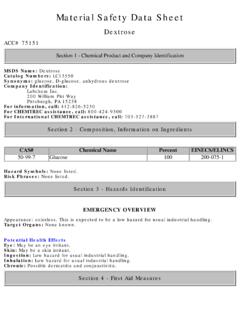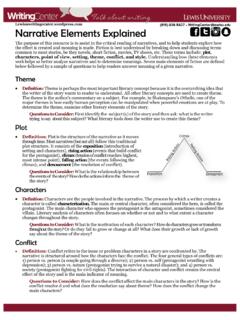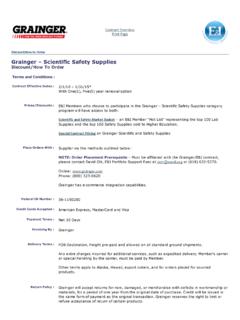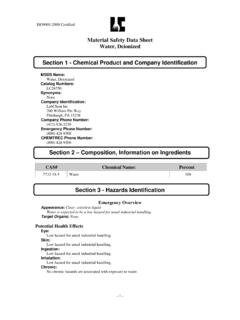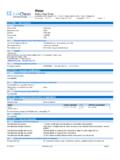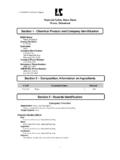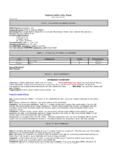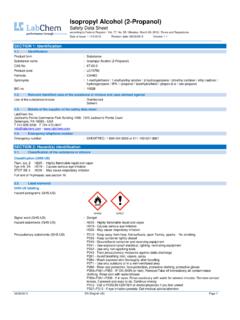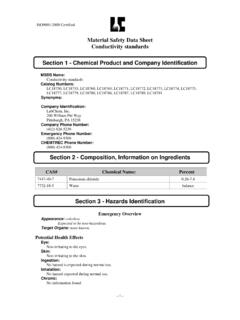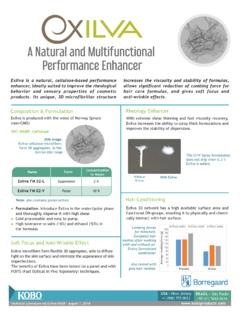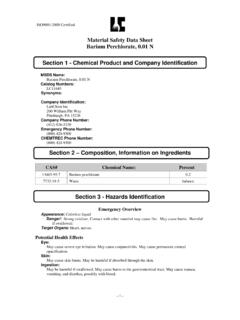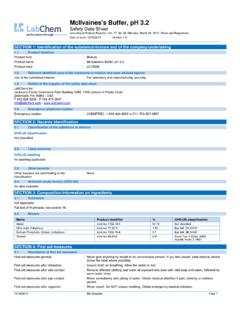Transcription of Material Safety Data Sheet - Lewis University
1 Material Safety Data SheetBarium chlorideACC# 75173 Section 1 - Chemical Product and Company IdentificationMSDS Name: Barium chlorideCatalog Numbers: LC11560 Synonyms: barium chloride dihydrate, barium dichlorideCompany Identification: labchem Inc. 200 William Pitt Way Pittsburgh, PA 15238 For information, call: 412-826-5230 For CHEMTREC assistance, call: 800-424-9300 For International CHEMTREC assistance, call: 703-527-3887 Section 2 - Composition, Information on IngredientsCAS#Chemical NamePercentEINECS/ELINCS10326-27-9 Barium chloride dihydrate99+unlistedHazard Symbols: None Phrases: None 3 - Hazards IdentificationEMERGENCY OVERVIEWA ppearance: white.
2 Warning! Do not taste or swallow. Do not take internally. Harmful or fatalif Organs: None Health EffectsEye: May cause redness, tearing, irritation, burning, blurred : May cause swelling and : Harmful if swallowed. Larger doses cause cardiac and respiratory failure, kidney andGI tract hemorrhage. Paralysis, hypokalemia, heart disorder may : Toxic effects of mist inhalation including muscle tightness, salivation, vomiting,diarrhea, abdominal pain, convulsions, tremors, anxiety, dyspnea, slow pulse, : Exposure may result in mucous membrane irritation, dermatitis, conjunctivitis. Maycause 4 - First Aid MeasuresEyes: Flush eyes with plenty of water for at least 15 minutes, occasionally lifting the upper andlower lids until no evidence of chemical remains.
3 Get medical aid at : Get medical aid. Immediately flush skin with plenty of soap and water for at least 15minutes while removing contaminated clothing and shoes. Remove contaminated clothing : Get medical aid at once. Give oxygen if respiration is depressed. Induce vomiting(touch finger to back of throat) keeping head lower than hips (prevent aspiration into lungs).Give conscious non-convulsive victim two tablespoons of epsom salts (magnesium sulfate) in aglass of warm water, then 2-4 glasses of : Give artificial respiration if necessary. Get medical aid. Keep victim warm, at victim to fresh to Physician: Treat symptomatically and 5 - Firefighting MeasuresGeneral Information: Emits toxic fumes when involved in a fire.
4 Containers may explode in theheat of a fire. Negligible fire and explosion hazard when exposed to heat or flame. Movecontainer if possible, avoid breathing vapors or dust. Wear self-contained breathing apparatusand protective clothing to prevent Media: For small fires, use dry chemical, carbon dioxide, water spray oralcohol-resistant 6 - Accidental Release MeasuresGeneral Information: Use proper personal protective equipment as indicated in Section : Absorb spills with absorbent (vermiculite, sand, fuller's earth) and place in plasticbags for later 7 - Handling and StorageHandling: Wash thoroughly after handling.
5 Avoid breathing dust, vapor, mist, or : Store capped at room temperature. Store in amber containers. Protect from heat 8 - Exposure Controls, Personal ProtectionEngineering Controls: Provide local exhaust or general dilution LimitsChemical NameACGIHNIOSHOSHA - Final PELsBarium chloridedihydratenone listednone listednone listedOSHA Vacated PELs: Barium chloride dihydrate: No OSHA Vacated PELs are listed for Protective EquipmentEyes: Do not wear contact lenses when working with chemicals. An eye wash fountain should beavailable in the immediate work area. Wear splash-proof Safety : Wear appropriate protective gloves to prevent skin : Wear appropriate protective clothing to prevent skin : Not required for normal use.
6 Firefighting-- any self-contained breathing apparatuswith full facepiece operated in pressure-demand 9 - Physical and Chemical PropertiesPhysical State: PowderAppearance: whiteOdor: odorlesspH: neutralVapor Pressure: mm Hg @20 CVapor Density: Not Rate:Not : Not Point: 2840 deg FFreezing/Melting Point:1760 deg FDecomposition Temperature:Not Temperature: Not Point: Not Rating: Not Limits, Lower:Not : Not : Gravity/ Formula:Not Weight:Not 10 - Stability and ReactivityChemical Stability: Stable under normal temperatures and to Avoid: Incompatible with Other Materials: None Decomposition Products: Oxides of nitrogen, oxides of carbon, oxides of Polymerization: Not 11 - Toxicological InformationRTECS#:CAS# 10326-27-9 :Not :CAS# 10326-27-9:ACGIH: A4 - Not Classifiable as a Human Carcinogen (listed as Barium).
7 Epidemiology: Barium chloride mist is toxic. Barium Chloride solutions are an eye, skin, mucousmembrane irritant: poisoning affects central nervous, gastrointestinal, and muscular : No data Effects: No data : No data : No data Studies: No data 12 - Ecological InformationNo information 13 - Disposal ConsiderationsChemical waste generators must determine whether a discarded chemical is classified as ahazardous waste. US EPA guidelines for the classification determination are listed in 40 CFR Additionally, waste generators must consult state and local hazardous waste regulationsto ensure complete and accurate P-Series: None U-Series: None 14 - Transport InformationUS DOTIATARID/ADRIMOC anada TDGS hipping Name:BARIUMCOMPOUNDS, (BARIUMCHLORIDE)No Number:UN1564 Packing Group:PG IIIS ection 15 - Regulatory InformationUS FEDERALTSCACAS# 10326-27-9 is not on the TSCA Inventory.
8 It is a hydrate and exempt from TSCAI nventory requirements ( (u)(2)).Health & Safety Reporting ListNone of the chemicals are on the Health & Safety Reporting Test RulesNone of the chemicals in this product are under a Chemical Test 12bNone of the chemicals are listed under TSCA Section Significant New Use RuleNone of the chemicals in this Material have a SNUR under 302 (RQ)None of the chemicals in this Material have an 302 (TPQ)None of the chemicals in this product have a CodesCAS # 10326-27-9: acute, 313 This Material contains Barium chloride dihydrate (listed as ** undefined **), 99%, (CAS#10326-27-9) which is subject to the reporting requirements of Section 313 of SARA Title III and40 CFR Part Air Act:This Material does not contain any hazardous air pollutants.
9 This Material does not contain anyClass 1 Ozone depletors. This Material does not contain any Class 2 Ozone Water Act:None of the chemicals in this product are listed as Hazardous Substances under the CWA. Noneof the chemicals in this product are listed as Priority Pollutants under the CWA. None of thechemicals in this product are listed as Toxic Pollutants under the :None of the chemicals in this product are considered highly hazardous by # 10326-27-9 is not present on state lists from CA, PA, MN, MA, FL, or No Significant Risk Level: None of the chemicals in this product are RegulationsEuropean Labeling in Accordance with EC DirectivesHazard Symbols:Not Phrases: Safety Phrases:WGK (Water Danger/Protection)CAS# 10326-27-9: 1 CanadaCanadaNone of the chemicals in this product are listed on the DSL or NDSL list.
10 WHMIS: Not # 10326-27-9 is not listed on Canada's Ingredient Disclosure LimitsCAS# 10326-27-9: OEL-AUSTRALIA:TWA mg(Ba)/m3 OEL-AUSTRIA:TWA mg(Ba)/m3 OEL-BELGIUM:TWA mg(Ba)/m3 OEL-DENMARK:TWA mg(Ba)/m3 OEL-FINLAND:TWA mg(Ba)/m3 OEL-GERMANY:TWA mg(Ba)/m3 (total dust) OEL-HUNGARY:STEL mg(Ba)/m3 OEL-THE NETHERLANDS:TWA (Ba)/m3 OEL-THE PHILIPPINES:TWA mg(Ba)/m3 OEL-POLAND:TWA mg(Ba)/m3;STEL mg(Ba)/m3 OEL-SWITZERLAND:TWA mg(Ba)/m3;STEL 1mg(Ba)/m OEL-TURKEY:TWA mg(Ba)/m3 OEL-UNITED KINGDOM:TWA mg(Ba)/m3 OEL IN BULGARIA, COLOMBIA, JORDAN, KOREA check ACGIH TLV OELIN NEW ZEALAND, SINGAPORE, VIETNAM check ACGI TLVS ection 16 - Additional InformationMSDS Creation Date: 8/30/1998 Revision #1 Date: 12/06/2000 Information in this MSDS is from available published sources and is believed to be accurate.
